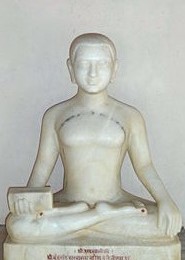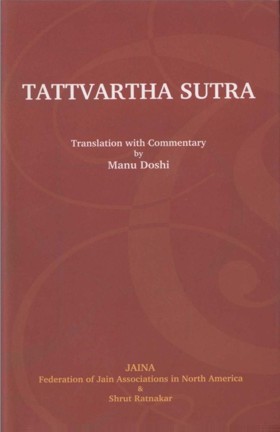02.01 Aupashamikkshāyikau Bhāvau Mishrashcha Jeevasya Swatattvamaudayikpārinamikau Cha
Audio: Sanskrit: औपशमिकक्षायिकौ भावौ मिश्रश्च जीवस्य स्वतत्त्वमौदयिकपारिणामिकौ च ।
Hindi: औपशमिक, क्षायिक और मिश्र (क्षायोपशमिक) ये तीन तथा औदयिक, पारिणामिक ये दो, कुल पांच भाव हैं। ये जीव के स्वरूप हैं।
02.02 Dwinavāshtādashaikvinshatitribhedā Yathākra-mam
Audio: Sanskrit: द्विनवाष्टादशैकविंशतात्रिभेदा यथाक्रमम् ।
Hindi: उक्त पांच भावों (औपशमिक, क्षायिक, क्षायोपशमिक, औदयिक और पारिणामिक) के अनुक्रम से दो, नौ, अठारह, इक्कीस और तीन भेद है।
02.03 Samyaktvachāritre
Audio: Sanskrit: सम्यक्त्वचारित्रे ।
Hindi: सम्यक्त्व और चारित्र ये दो औपशमिक भाव है।
02.04 Jnāndarshandānlābhbhogopabhogviryāni Cha
Audio: Sanskrit: ज्ञानदर्शनदानलाभभोगोपभोगवीर्याणि च ।
Hindi: ज्ञान, दर्शन, लाभ, भोग, उपभोग, वीर्य, सम्यक्त्व और चारित्र ये नौ क्षायिक भाव है।
02.05 Jnanajnāndarshandānadilabdhayashchatustrit-ripanchbhedahYathākramam Samyaktvachāritrasanyamās-anyamāshcha
Audio: Sanskrit: ज्ञानाज्ञानदर्शनदानादिलब्धयश्चतुस्त्रित्रिपञ्चभेदा: यथाक्रमं सम्यक्त्वचारित्रसंयमासंयमाश्च ।
Hindi: चार ज्ञान, तीन अज्ञान, तीन दर्शन, पांच दानादि लब्धियां, सम्यक्त्व, चारित्र (सर्वविरित) और संयमासंयम (देशविरित) ये 18 क्षायोपशमिक भाव है।
02.06 Gatikashaylingamithyādarshanājnanāsanyatāsid-dhatvaleshyāhchatushchatustrayekaikaikaikashadbhedāh
Audio: Sanskrit: गतिकषायलिङ्गमिथ्यादर्शनाऽज्ञानाऽसंयताऽसिद्धत्वलेश्याश्चतुश्चतुस्त्र्येकैकैकैकषड्भेदा ।
Hindi: चार गतियां, चार कषाय, तीन लिङ्ग (वेद), एक मिथ्यादर्शन, एक अज्ञान, एक असंयम, एक असिद्धभाव और छ: लेश्याएं ये 21 औदायिक भाव है।
02.07 Jeevbhavyābhavyatvādini Cha
Audio: Sanskrit: जीवभव्याभव्यत्वादीनि च ।
Hindi: जीवत्व, भव्यत्व, अभव्यत्व ये तीन तथा अन्य भी पारिणामिक भाव है।
02.01-07
English: These seven sutras deal with different modes of soul. As indicated in the last chapter, the mode denotes a changing state. The categories of Karma covered under different types of modes are a bit overlapping. That happens, because some of the Karmas relate to more than one mode. Such modes are mainly of five types depending upon the impact of Karma prevailing from time to time. The first four modes relate to the operative or inoperative phases of Karma, while the fifth is independent of that.
Suppression or pacification of the operative Karma is termed as Upasham and the mode prevailing in that state is called Aupashamik. That mode indicates a level of purity, which is comparable to that of water when its impurities are settled down. Obviously, that is not a lasting state. As the impurities settled at the bottom come up with disturbance in the water column, so does the suppressed Karma become operative when the soul comes across circumstances that are instrumental in activating it.
There are mainly eight main types and 97 categories of Karma. Four of the eight main types, viz. knowledge-obscuring, perception-obscuring, deluding and obstructing are termed as defiling Karma, because they defile the nature of soul. Of these four types, deluding Karma is the most hurtful, as it does not allow the soul to see the truth. The total Upasham can occur only of that type. Deluding Karma is of two categories. One deludes the perception and the other does the conduct. They are known as Darshan-Mohaniya and Chāritra-Mohaniya. Since both of them are subject to suppression, the Aupashamik mode resulting thereby relates to those two categories.
The lasting purity can arise when the bondage of Karma is destroyed. That is termed as Kshay and the mode in that state is called Kshāyik. Two kinds of omniscience-obscuring Karma (Kevaljnānāvaraniya and Kevald arshnā varan iya), five kinds of obstructing Karma (relating to charity, benefit, availing of consumable and durable goods and vigor) and the above mentioned two categories of deluding Karma are subject to destruction. As such, Kshāyik mode relates to those nine categories.
Destruction of a Karma means that the Karma no longer stays with the soul. But a soul can acquire a similar new Karma and in that case it has to bear the impact of the new Karma. Both kinds of omniscience-obscuring Karma are, however, the exceptions, because once they are destroyed, the soul attains omniscience and as such it is not going to acquire new Karma. The Kshāyik mode resulting from the destruction of omniscience-obscuring Karmas is therefore everlasting.
The above-mentioned two modes arise when the impact of Karma is either suppressed or destroyed. But there is also a state, where the impact is partly suppressed and partly destroyed. That is termed as Kshayopasham, which is a compound word of Kshay and Upasham. The mode arising thereby is therefore termed as Kshāyopashamik. Eighteen sub-categories of Karma, viz. obscured Matijnān, Shrutjnān, Avadhijnān and Manahparyayjnan; three types of nescience (Matiajnān, Shrutajnān and Avadhiajnān; three types of obscured perception (which are detailed later while discussing Nirākār Upayog); the above mentioned five kinds of obstructing Karma; and those relating to insight, conduct and restraint relate to the mixed mode.
It is possible that one may not be able to resort to any of the above modes or while resorting to such modes in respect of some Karma, he may not be able to do so in respect of other Karma. In that case, the mode stays in consonance with the operative Karma. Since the rise of Karma is known as Uday, the mode in accordance with that rise is called Audayik. That mode pertains to four types of existence, (human, heavenly, animal or infernal), four types of defilement, three types of sex inclination, wrong perception, one type of nescience, one type of non-restraint, embodiment and six types of aura. These twenty-one categories relate to the Audayick mode.
The fifth mode pertains to the intrinsic nature of soul and is known as Parināmik. It does not depend upon any external factor. Consciousness and being worthy or unworthy of liberation are three innate chaicatertsties of soul. The knowing capability of soul; being worthy of or its eligibility for liberation is obvious. It can, however, be unworthy or ineligible too. Jain tradition maintains that some souls are so addicted to wrong concepts that they cannot see the truth. As such, they cannot attain liberation. These three modes are thus innate to soul and are not related to any situation.
 Acharya Umaswati
Acharya Umaswati
